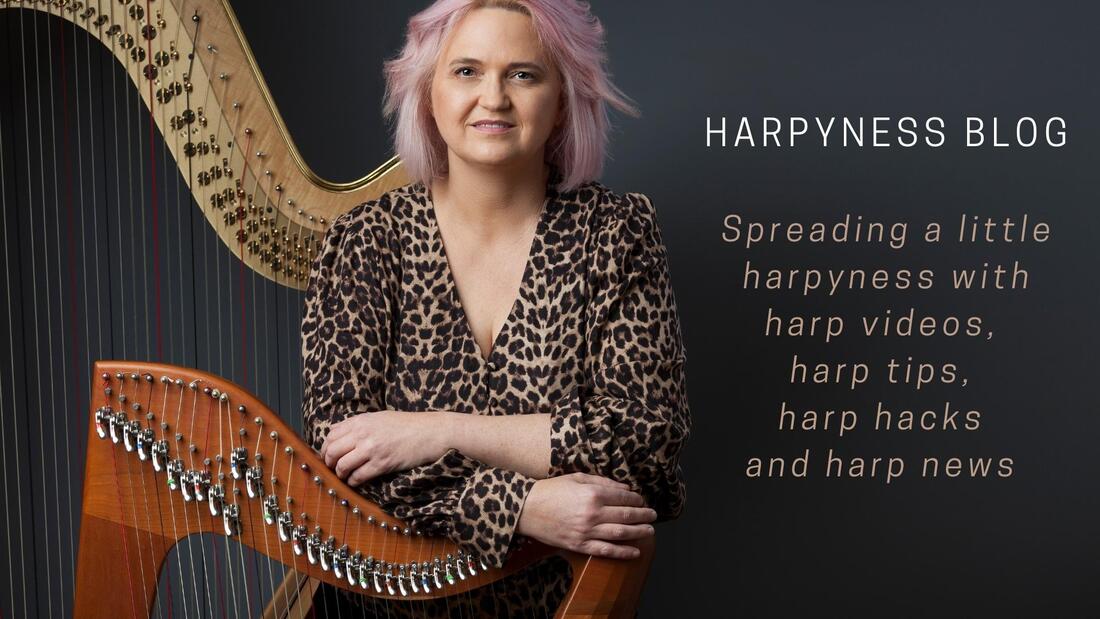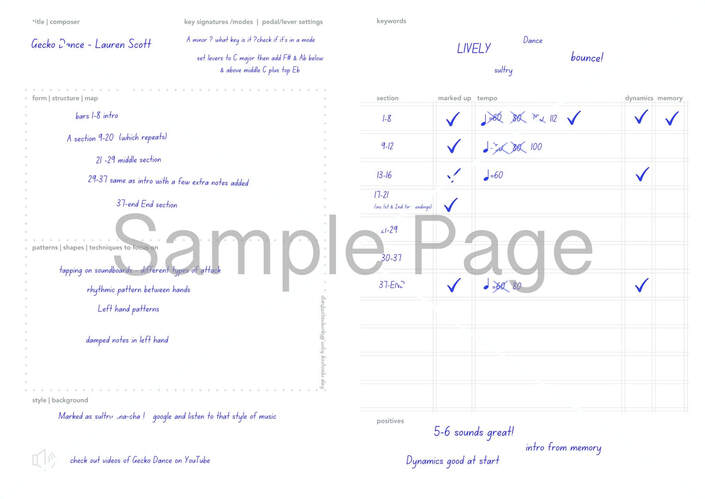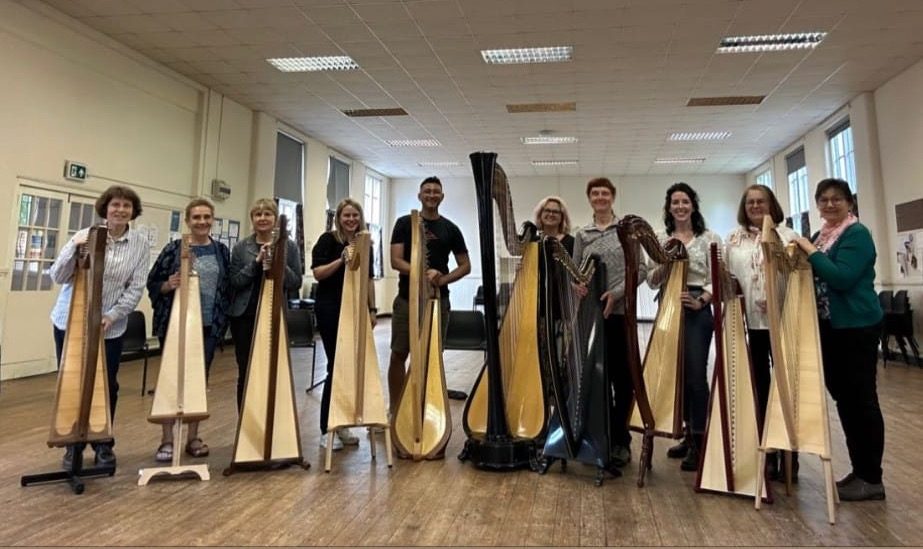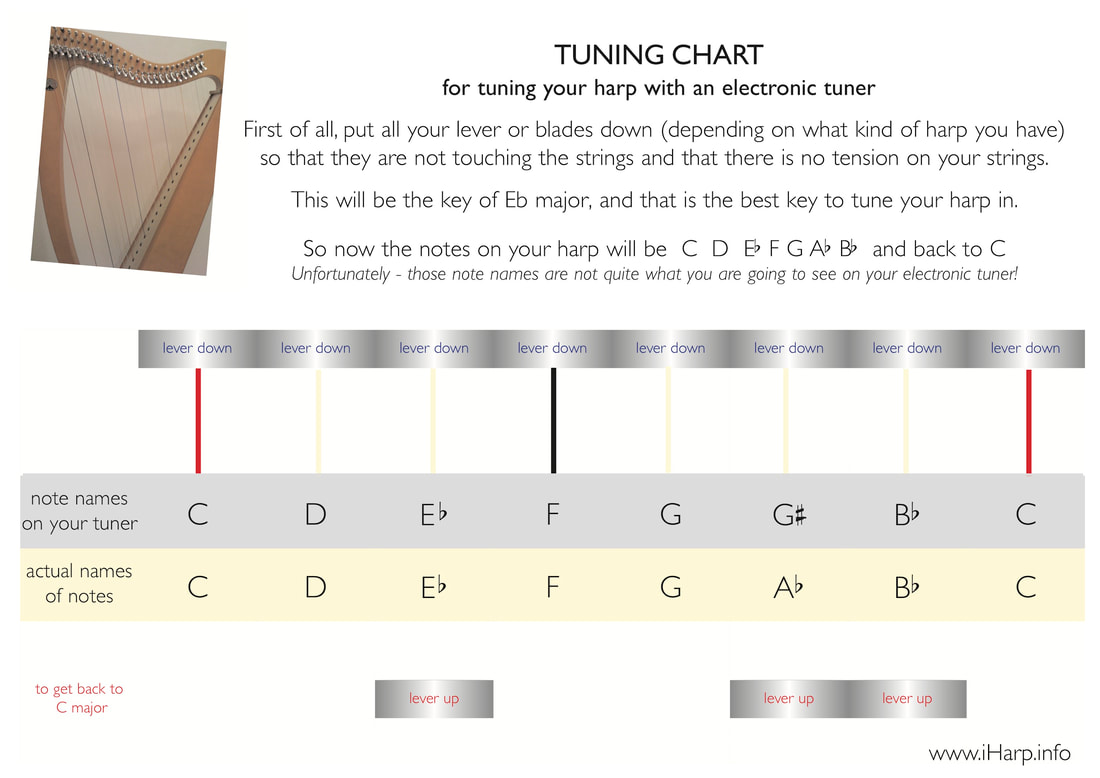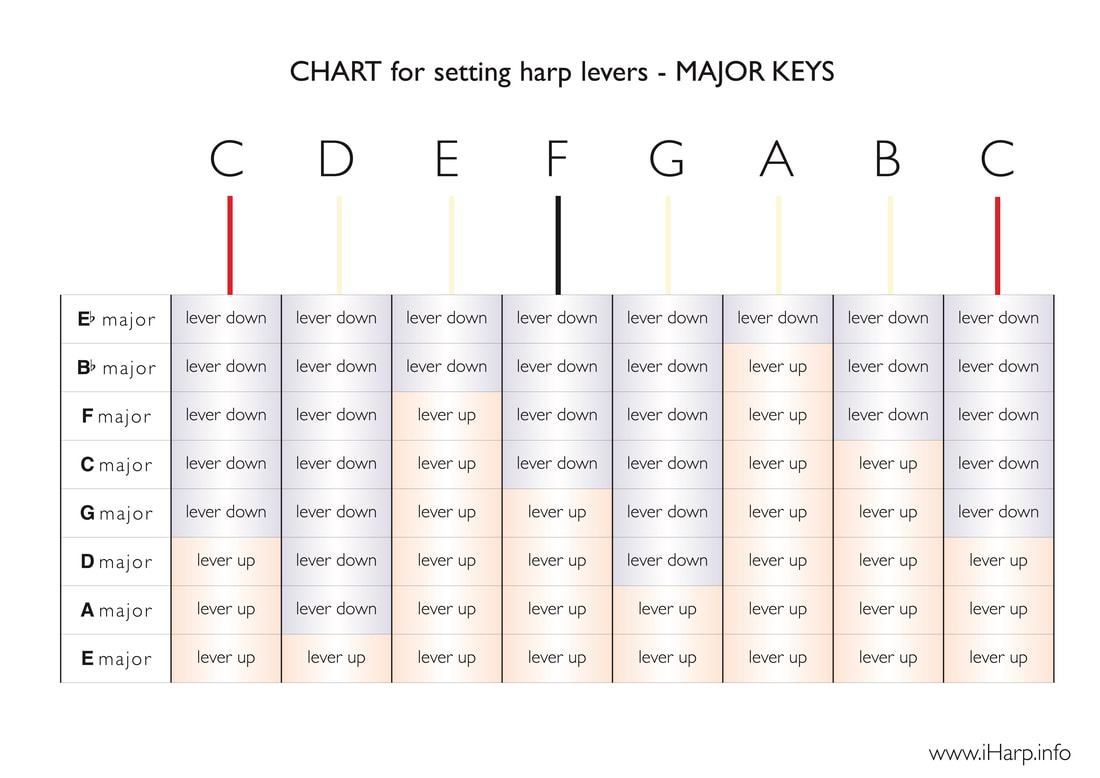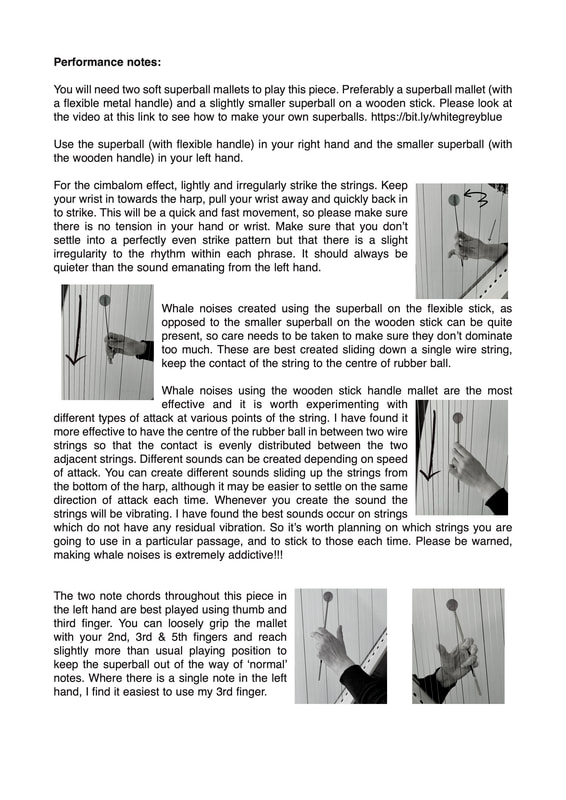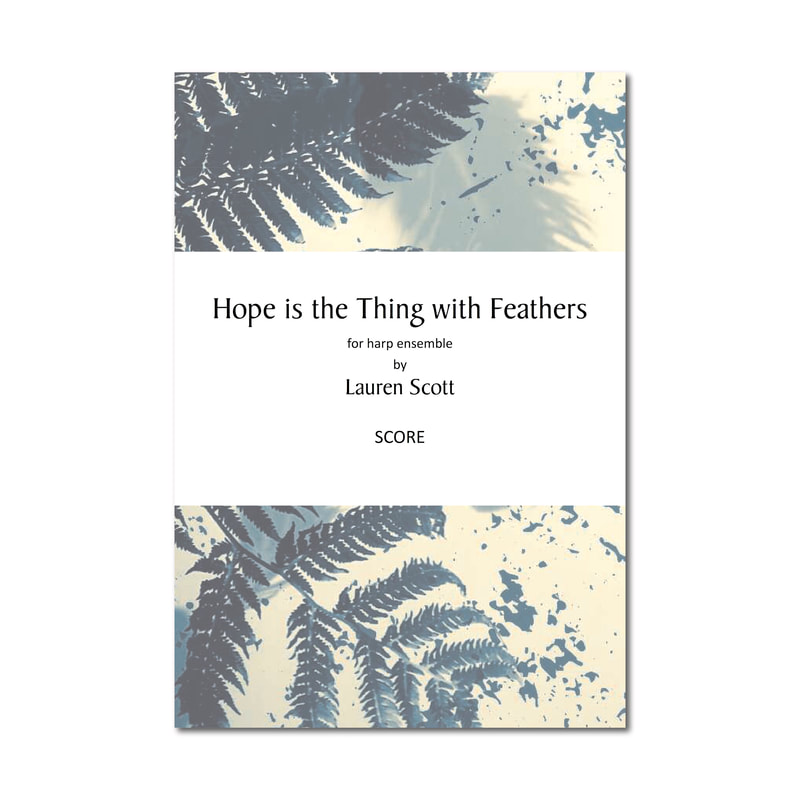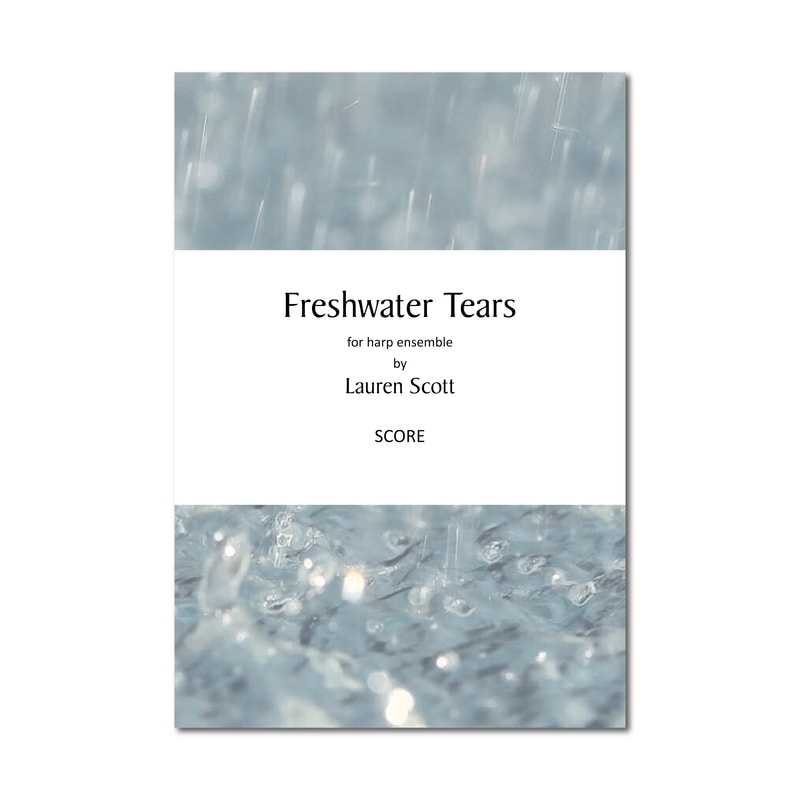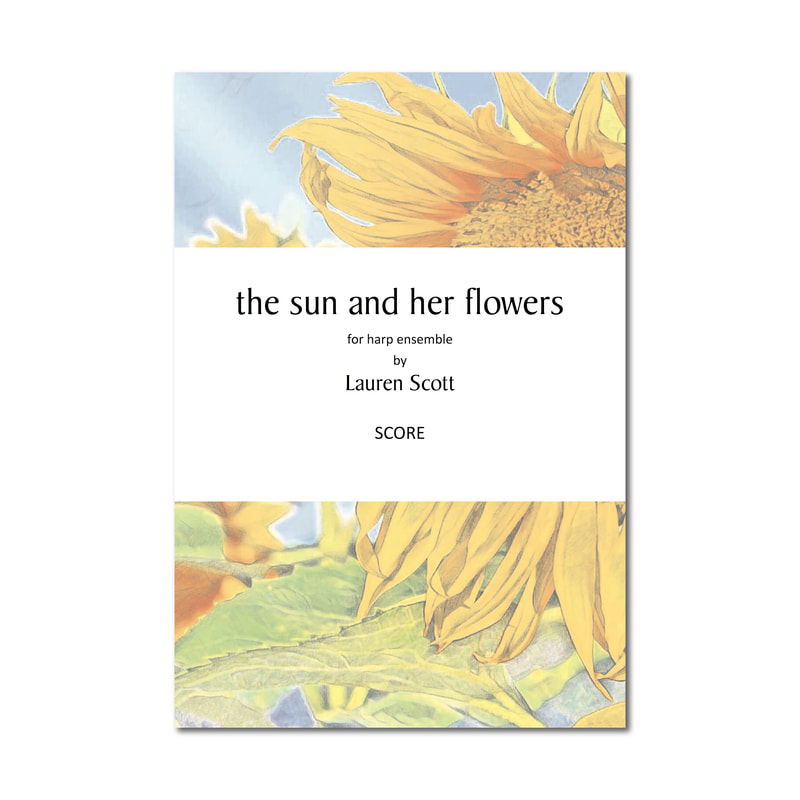|
The stars were aligned when Amy Turk came up to chat to me after a concert I had given in a rural church in Cheshire last July. She had recently moved and now lived only 20 minutes away from me. We had to meet up and have dinner! After many long chats & meals together we found out that we were both near to completion on our respective new album releases. So we made a plan to work collaboratively to promote our releases together. We set it so that Amy’s debut EP “Syzygy” and my second album “Sea of Stars” would be released on the same day, 19th April 2024. As we both had composed harp duos, playing these together naturally framed a carefully curated concert of our own compositions and arrangements. Whereas Amy’s compositional focus has been on pedal harp and mine on lever harp; we both share an imaginative and creative approach to our writing. Invented techniques meet beautiful melodies, fused by our collective influences from classical, rock, jazz, film music and video games. Our first collaborative video together ! In true pioneering style our joint album launch party was a live online event hosted on Amy’s YouTube channel where she is one of the most watched solo harpists and has over 30 million views. As well as performing live we had an interactive Q&A as well as listening to a couple of tracks from our respective releases. We gave a series of concerts and workshops in May in the UK and we wanted to take the spirit of ‘harpists helping each other” a step further, so it was important for us to share our concert platform with local harpists as much as possible. Our London concert featured performances from Trinity Laban harpists, our Alton concert featured harpists from Bedales School & Southampton University and our Manchester concert featured RNCM harpists. A huge thank you to the harp teachers for their support in this project and allowing their students to perform: Gabriella Dall'Ollio, Kate Ham, Cecily Beer and Anne-Marie O'Farrell. Here is a clip from our performance in London A chance encounter after a concert has created a friendship built on mutual respect and we look forward to more projects together and sharing our Harp Alchemy with the harp community.
0 Comments
Video of how to play the extended techniques in ON A BLUE HILL
COMING SOON Inspired by bio-luminescent plankton that glow in the dark, flashing arpeggio figures, the hum of rapid harmonics and a variety of extended techniques evoke this most magical of phenomena to scintillating effect. Sea of Stars was written in January 2020 and premiered by Lauren Scott and Eleanor Turner in an online performance in October 2020. Originally written for lever harp & pedal harp duo, I have subsequently arranged this piece for harp quartet. The quartet version can be played on 4 pedal harps or mixture of lever & pedal harps. Video of how to play the extended techniques in Sea of Stars I've recently created some practice templates which are available for free from my online shop on this website. It's a learning resource suitable for all musicians (not just harpists) and for any level of player. As such i've created 2 versions, 1 for harpists and a general one for non-harpists. Here is a mock "filled in" version which hopefully gives an idea of how you can use them I'd love you to have a go and see how you get on using them. Please do let me know if you find them useful !
There's more information on how to use them in my web shop. link below I can't believe I only started Cheshire Harps in February. It's been totally joyous organising this monthly meet for adult harpists in the North West, Cheshire area. We meet in Sandbach which is very close to junction 17 of the M6, and we do a 2 hour session on (roughly) the second Sunday of each month. As a result of organising this it's been a great opportunity to delve into the harp ensemble repertoire that is available and also to arrange some new music for the ensemble. Here are a couple of new arrangements that I have done recently. New members to Cheshire Harps are always welcome. Email me if you’d like to join us!
Initial set up with your harp Tip 1. Are you sitting correctly?This may sound obvious, but it's important to sit so that YOU are comfortable with no twisting or bending of your spine and that you adjust the harp to you. Rather than you adjusting your body to the harp. You should never be feeling uncomfortable when you play the harp. If you do have any aches - STOP! Put the harp down and check your posture.
Now that you are centred, move the harp back towards your shoulder so that it 'fits' you in this balanced position. You might need to put the legs of your harp away from you a little bit . You also might need to twist the angle of the harp a little bit so that it's not 'square' on to you, but more 10 degrees to the left. The harp when it tilts back towards you is aiming towards your right shoulder and not your head! Tip 2. How to tune your harpTo get the most out of your lever harp, you want to be able to play in as many keys as possible. Tuning in Eb major gives you the most useful range of keys. With all levers down the harp needs to be tuned into Eb major. If you don't already have one, get yourself an electronic tuner. They are very cheap to buy and you can also get an app to download to your phone. Check this chart when you first start to tune to check you know which notes you are looking for on your tuner - Ab will show up as G sharp on the tuner!
Top Tip 3. Setting the leversYou 'base' key that you are going to set your harp in the most will be C major, so you need to get used to setting it quickly to that key.
Levers work by engaging with the string to make the string shorter in length and thereby sharper. When the lever is off there is no engagement with the string and the string is at it's maximum length. However, the mechanics of the levers can differ according to the make and age of the harp. Some levers go up and down, some twist from side to side. Some will sharpen a string by going up, and some do the reverse. To make it easier the charts below are colour coded red and blue. red = hotter = lever on = sharp blue = colder = lever off = flat On your particular harp to get a sharp may be lever up or lever down! The majority of harps are levers up for sharp, but get to know what it is for you. Until you know and remember all the other key signatures, when you look at a new piece of music, check the key signature at the start and do whatever it says - from your base key setting of C major. so if it's a piece with sharp signs - you set to C major, and if it has one sharp in the key signature (G major) then you put your F levers on. If it's a piece with 2 flats in the key signature (Bb major) then you take the B & E levers off from your base key of C major. It won't take long to get used to the levers! When you aren't playing your harp, put all the levers back into neutral position of all levers off which is Eb major Don't worry it takes a while to understand at first, but it won't be long until it all makes sense and you are flipping levers like a pro! "These pieces are creative, fun, and challenging" Harp Column magazine
It's wonderful to have my Adventures for Lever Harp series reviewed in the latest Harp Column magazine. It's a lonely old business composing, so it means a lot to get positive reviews for my music. Adventures for Lever Harp Book 1 started out as a... "could I do this?" project in 2018 (having never composed before) to fill a gap in providing advanced level lever harp music for my students. Book 2 quickly followed and music from these two collections featured on my first solo album released on the Avie Records label. Book 3 developed during Covid lockdowns and pieces from that collection will feature in my second album which I'm hoping to release soon. Writing the Adventures for Lever Harp series spearheaded my new found love for composition and helped me to secure a PRS Foundation Women Make Music award, a DYCP grant from Arts Council England as well as becoming composer in residence with Harps North West for a year. I certainly didn't think that when I started this project in 2018 it would change my artistic focus completely, but that's the joy of some projects! Harp teachers, please do have a look at these pieces for your students. They are featured in Trinity and AMEB syllabuses and all 15 pieces are very different in style. FInally, if any harpists would like to commission me to write them a bespoke piece of music, please do get in touch! I recently wrote a new piece for solo harp called WHITE GREY BLUE which is about whales in the Arctic. The piece uses extended techniques throughout to create the sound world of whales singing and ice cracking. To create the sounds you need to use two superballs. The first effect is making whale noises which is really effective on the harp. But you need the right kind of superball to make the sounds! In this video I show you how to make your own superballs to create this extended technique. The second extended technique is hitting the strings very quickly to create a cimbalom sound. The sheet music for White Grey Blue is available HERE WHITE GREY BLUE As the longer periods of sunlight begin to melt the Arctic ice, the elusive blue whale starts to come inland and feed in near-shore waters. Using two superball mallets on the harp, white grey blue explores the sound world of summer in the Arctic. The irregular pulsing of struck strings (using a percussion mallet to imitate the sound of a cimbalom) represents the cracking and melting of the ice. The eerie song of whale noises are created by extended techniques unique to the harp. Both these sounds flow through this hymn evoking the largest and noblest of creatures on this planet. A while back, a blind friend of mine asked me to help her with restringing her harp as she had quite a few broken strings. She is a beginner harpist and was struggling a little bit with navigating her way around the harp. I said to her that I would investigate to see if there was a solution, so I got in contact with harp maker Mark Norris. I was making a visit up to Mark's harp studio in Peebles, Scotland so I had a chat to him about it and was delighted that he was up for exploring the possibilities of what could be done. He has been brilliant in finding a solution for her and in the end he developed a special textured varnish to apply to the strings. He sent me the varnish kit through the post and I made a short video explaining the whole process here of adapting the harp. After the harp was finished the big test was getting the harp back to my friend and what she thought about it all. She said that the textured strings were effective and helpful in finding her way round the harp!
It was interesting to see how she played her harp and in her case, it seemed that as well as applying the textured varnish lower down on the strings, it would also have been useful to apply it high up as well. It seemed more natural for her to slide her fingers up the string, rather than down the string to feel the textured guides. To sum up - a thin band of two coats of textured varnish applied in an inch wide band low down on the string were fine on the middle C string and lower. This didn't affect the sound quality of the string. All the strings higher than middle C were better with only 1 coat of varnish. Many thank to Mark Norris for being a total star with his time and effort in developing a solution for my friend. Mark Norris Harps. and order strings online at HarpStrings.Biz On my trip to Scotland to visit Mark Norris's studio he showed me how to tie the perfect harp knot HERE I've been buying my harp strings from Mark Norris for a while now https://www.harpstrings.biz/ and I recently have been chatting to him online about the possibly of adapting some strings to make them suitable for a blind harpist friend of mine. One thing led to another and I told Mark about my own customised string set up and that the intonation of my levers left a little to be desired. I was a bit nervous about telling a harp maker how I had dived in and started customising and playing around with a harp set-up, but he was extremely generous and said that he would have a good look at my harp and fix my levers so that it would be properly in tune! I know Mark doesn't normally look at other makes of harps apart from his own, so it was an extremely generous offer from him. So this meant a long drive to his studio in Scotland which was 8 hours of driving in total there and back from my home. But I took lots of breaks and what a splendid drive it was. I had to stop to take a picture of the view near to his studio. I have to admit to being a complete harp nerd, and visiting a harp makers studio is heaven for me! Absolutely amazing to see a craftsman at work and to see harps in various stages of being built. Whilst I was there Mark showed me a new project of his called Nifty Harps, and they are absolutely fab. He's developing a professional model and I can't wait to order a 27 string one next year. They are affordable harps with a really good sound and have a wrap around detached soundboard. Think along the lines of cardboard harps, but made with rolled wood. An absolutely brilliant project https://niftyharps.scot/ Mark was fitting a string whilst we were chatting and I couldn't believe the speed he went at. So here he is demonstrating tying the perfect harp knot slowly for me, and it's still so quick! Amazing! And to top it all off, Mark fixed the intonation on my harp.
Thank you Mark! We are nearly there with a possible solution on the strings for blind harpists, and I'll post about that another time
I was absolutely thrilled that one of my solo lever harp pieces was selected for the The Big Lockdown Music Survey by NMC Records.
Funded by the Arts Council England National Lottery Project Grant it is aiming to tell the story of lockdown in recorded music. You can read more about the project and listen to all the selected entries HERE I was selected for the NORTH region and the piece that was chosen to be part of this project is The First Snowdrops which is an Eric Satie inspired piece that I wrote during the first UK Lockdown.
My latest ensemble piece written for Harps North West is a multi-level 3 part ensemble called Carousel of Dreams. Inspired by Japanese Anime films from Studio Ghibli, the piece has a dreamy, fantasy like quality.
HARP NORTH WEST MEMBERS
Below are slower practice versions of the 3 sections, each with a count in. Please contact Gill at Harps North West for the sheet music.
Finally, this is the whole piece at the slower tempo with click added
Originally written as a solo piece in Adventures for Lever Harp Book 2, and featuring on Lauren's debut album, Beyond the Horizon, Blue Moon Rising has been included in BBC Introducing and Apple Music playlists and has had nearly a million streams online to date! Blue Moon Rising for ensemble is now available as a 3 part harp ensemble piece and is approachable for late beginner to intermediate standard players. The solo version is advanced but approachable by intermediate players once you have worked out how to play the extended technique demonstrated below. This piece is based on the same structure as a Haiku; a Japanese poem which consists of 3 lines. The 1st line is 5 syllables, 2nd line is 7 syllables and 3rd line is 5 syllables. The piece has a a recurring 3 bar/measure pattern which is in 5/4 7/4 5/4 . It was written during a very (rare) hot period in the summer of 2018 in the UK, which coincided with a supermoon. You could almost see the heat rising off the hills in the stillness of the night. Another hot day Reaching for the cooler air A Blue Moon rises The piece consists of an undulating bass line, and on top sits a simple melody (the blue moon) which gradually rises. When the moon reaches it's highest point you then can hear the heat rising by use of an unusual special effect on harp which Lauren demonstrates in the videos below. Listen to Blue Moon Rising on Spotify below "Blue Moon Rising" is also known as "A Blue Moon Rises" which was it's original name when it was first published!
Lauren has recently created a mega Beatles Medley in 4 parts which has been carefully crafted to be a multi-level harp ensemble piece full of easy extended techniques which is fun to play for players of all levels. If you run a harp quartet or ensemble please contact Lauren HERE if you are interested in using this arrangement. On this page there are videos demonstrating the special effects used in Lauren's harp ensemble piece Harps Across the North. Hope is the Thing with FeathersInspired by the poem by Emily Dickenson, Hope is the Thing with Feathers is a Round in four parts and incorporates preparation with cardboard in the middle octave to create the effect of pitched drums. Inspired by the sense of 'ritual' and 'power' behind the New Zealand Haka, the Maori word for "hope" - tumanako - is broken up into separate syllables and woven into the Round so that the word in it's entirety is chanted three times throughout the piece. Hope is the Thing with Feathers was written for the Old Malton Harp Group in North Yorkshire and funded by PRS Foundation Women Make Music.
Freshwater TearsInspired by the Rain Stone poem by Simon Armitage, Freshwater Tears is written in four parts and uses various extended techniques to create the effect of raindrops including xylophonics, percussive tapping on the harps and a special tremelo xylophonic glissando technique which Lauren has developed. This piece is inspired by the joy of rain which is so beautiful demonstrated in the poem, Freshwater Tears was written for Harps North West in Cumbria and funded by PRS Foundation Women Make Music.
the sun and her flowersInspired by a short poem by Rupi Kaur, the sun and her flowers is written in four parts and uses various preparations including paper woven between the strings to make the sound of a Kalimba, paperclips & coils placed on the base of strings to make the sound of buzzing bees, and clips placed on a bass note to sound like a joyous and raucous rattle in the final part of this piece. After a calm introduction of short cadenzas the sun wakes up and the sound of the kalimba creates a groove over which the flowers dance. the sun and her flowers was written for Harps of the North directed by Anita Aslin and funded by PRS Foundation Women Make Music.
|
Categories
All
AuthorLauren Scott is a harpist & composer and has been blogging on Harpyness for over 10 years. If you enjoy reading Harpyness and you'd like to buy me a virtual coffee that would be very welcome. Cheers!
Archives
June 2024
|
